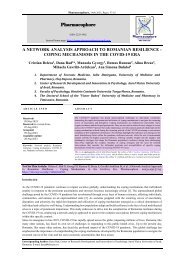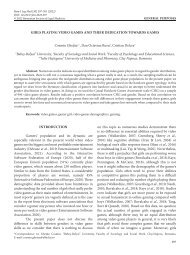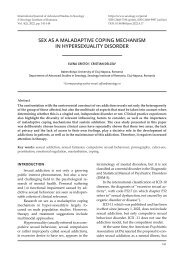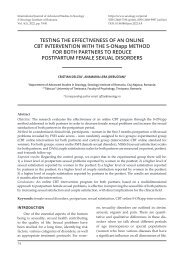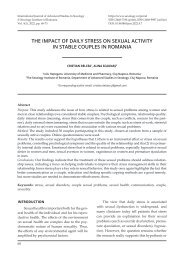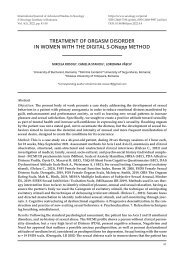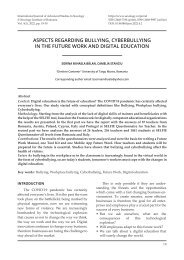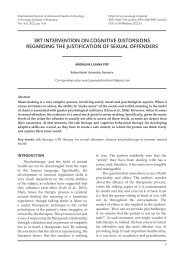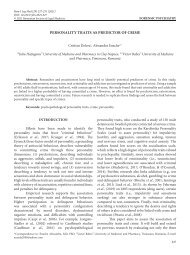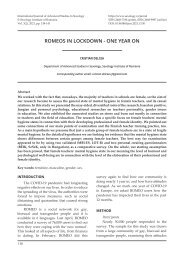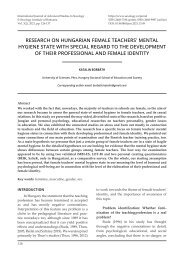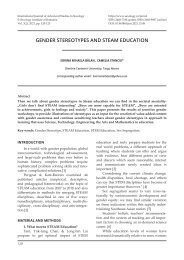SYMPTOMATOLOGY OF RECONSTITUTION OF TRAUMA IN ADULTS WITH A HISTORY OF CHILDHOOD SEXUAL ABUSE. AN APPROACH FROM THE PERSPECTIVE OF SONapp APPLICATION
Adults with a history of childhood sexual abuse often experience symptoms derived from lived traumatic experiences, which are analogous to many of the criteria of diagnosis of Borderline Personality Disorder (BPD) but also with those of stress disorder post-traumatic stress disorder (PTSD). We will briefly examine these symptoms in the context of a framework trauma, to conclude later whether symptomatic behaviors may be indicative more accurate for a post-traumatic response, especially in terms of behavior reconstitution or re-experience of trauma. Recognition of self-harm behavior or masochistic tendencies in adult survivors of sexual abuse trauma as an attempt to reconstitution of sexual trauma suffered in childhood, rather than as a manifestation characteristic of personality disorders, serves to establish an appropriate diagnosis, mental health professionals can continue to focus on the consequences of trauma unresolved sexual issues rather than personality restructuring. (Standardized intervention model SON, Delcea C., 2019) Thus, seek to We understand clients in a trauma setting can provide a more objective treatment climate and can minimize the stigma that may result potentially from making an inappropriate diagnosis borderline personality disorder (BPD).
Adults with a history of childhood sexual abuse often experience symptoms derived from lived
traumatic experiences, which are analogous to many of the criteria of diagnosis of Borderline Personality
Disorder (BPD) but also with those of stress disorder post-traumatic stress disorder (PTSD). We will
briefly examine these symptoms in the context of a framework trauma, to conclude later whether
symptomatic behaviors may be indicative more accurate for a post-traumatic response, especially
in terms of behavior reconstitution or re-experience of trauma. Recognition of self-harm behavior
or masochistic tendencies in adult survivors of sexual abuse trauma as an attempt to reconstitution
of sexual trauma suffered in childhood, rather than as a manifestation characteristic of personality
disorders, serves to establish an appropriate diagnosis, mental health professionals can continue to
focus on the consequences of trauma unresolved sexual issues rather than personality restructuring.
(Standardized intervention model SON, Delcea C., 2019) Thus, seek to We understand clients in a
trauma setting can provide a more objective treatment climate and can minimize the stigma that may
result potentially from making an inappropriate diagnosis borderline personality disorder (BPD).
You also want an ePaper? Increase the reach of your titles
YUMPU automatically turns print PDFs into web optimized ePapers that Google loves.
RODICA WEIHM<strong>AN</strong>N<br />
out guilt or revictimization, it is an absolutely<br />
necessary condition.<br />
Although the diagnosis of BPD can be<br />
helpful in identifying behaviors when consult<br />
with other mental health professionals about<br />
the stigma attached to the label can provide<br />
customer service by mislabeling behaviors as<br />
being characterological rather than adaptive<br />
behaviors (Miller, 1994).<br />
Miller and May suggested that a client who<br />
is recovering from childhood trauma should be<br />
understood through exploration maladaptive<br />
behaviors (e.g., self-harm, anger, relationship<br />
turmoil), rather than trying to silence them.<br />
Axis I diagnosis, BPD should be considered<br />
a subclassification of PTSD. In doing so, he<br />
indicated Hodges would reduce the stigma<br />
associated with BPD and integrate two<br />
categories of diagnosis apparently similar.<br />
The complexity of the implications and<br />
needs of the clients who show the symptoms<br />
of reconstitution trauma creates the need<br />
for a comprehensive assessment, treatment<br />
planning and psychotherapeutic intervention.<br />
Therefore, it seems necessary to take a<br />
therapeutic approach integrate emotional,<br />
behavioral and interpersonal awareness.<br />
It is essential to create a secure environment<br />
in which the customer can explore openly<br />
traumatic history. Customers should be helped<br />
to make conscious connections between their<br />
experiences past and reconstitution experiences,<br />
as the recognition of this connection will allow<br />
coping mechanisms to be more adaptable, to<br />
fall into the category of conscious reactions to<br />
stressful events (Miller, 1994).<br />
In order to recreate the cyclical pattern,<br />
clients should begin to recognize the cyclical<br />
pattern maladaptive and often destructive<br />
created when the expressed needs of a client<br />
are not fulfilled as a result of his behaviors.<br />
For subjects facing reconstitution of trauma,<br />
expressions of need (safety, trust, strength,<br />
esteem and privacy) in the way they are<br />
accustomed (reconstitution behaviors)<br />
result in rejection to any attempt by others<br />
to satisfy these needs, thus catching them in<br />
a cycle destructive. Clients who experience<br />
reconstitution of trauma often cause it<br />
simultaneously the closeness and emotional<br />
intimacy of a protective spectator, only to reject<br />
him in the the latter (Miller, 1994).<br />
Therefore, creating awareness and gaining<br />
the ability to satisfying needs through other<br />
more adaptive behaviors becomes the key to<br />
treatment clients facing trauma recreation.<br />
From a cognitive perspective, the<br />
distortions that result from childhood trauma<br />
and which result in anxiety, avoidant behavior,<br />
fear of betrayal, anger, and passivity feelings<br />
of helplessness should be realized and altered<br />
(Owens & Chard, 2001). Customers who<br />
experience the reconstitution of trauma may<br />
think that “their purpose in life” is to always<br />
relive and be punished constantly in response<br />
to the traumatic episode. Furthermore, they<br />
can maintain the cognitive distortion in which<br />
they feel guilty and that the perpetrator is in as<br />
a rule, in an attempt to manage the cognitive<br />
dissonance that results when a caregiver is<br />
simultaneously the source of safety and danger<br />
(Delcea C., Enache A., 2021). These and other<br />
specific beliefs or distortions each individual<br />
client should be challenged and eventually<br />
replaced with other cognitions stronger, selfaware.<br />
Miller (1994) outlines four approaches<br />
to trauma recovery treatment.<br />
In turn, it indicates that understanding<br />
the context surrounding the symptoms of<br />
reconstitution Trauma is fundamental to<br />
understanding and treatment. Miller states<br />
that by context she refers to “situations in<br />
which the person lives, interacts, thinks and<br />
experiences itself in relation to the world”.<br />
Miller suggests that there are several contexts<br />
that support logic ubiquitous reconstitution.<br />
Second, the symptoms should be viewed from<br />
a perspective historical, as an adaptation and<br />
communication of the individual past. In the<br />
third line, behavior should be seen as having<br />
many functions even when that behavior it is<br />
no longer necessary. For trauma victims, the<br />
symptoms become a companion, much less<br />
threatening than other new relationships or<br />
experiences and often their only source of power<br />
and control. Finally, Miller says the victim of<br />
trauma needs recovery at least a meaningful<br />
and healthy relationship before revisiting the<br />
38




